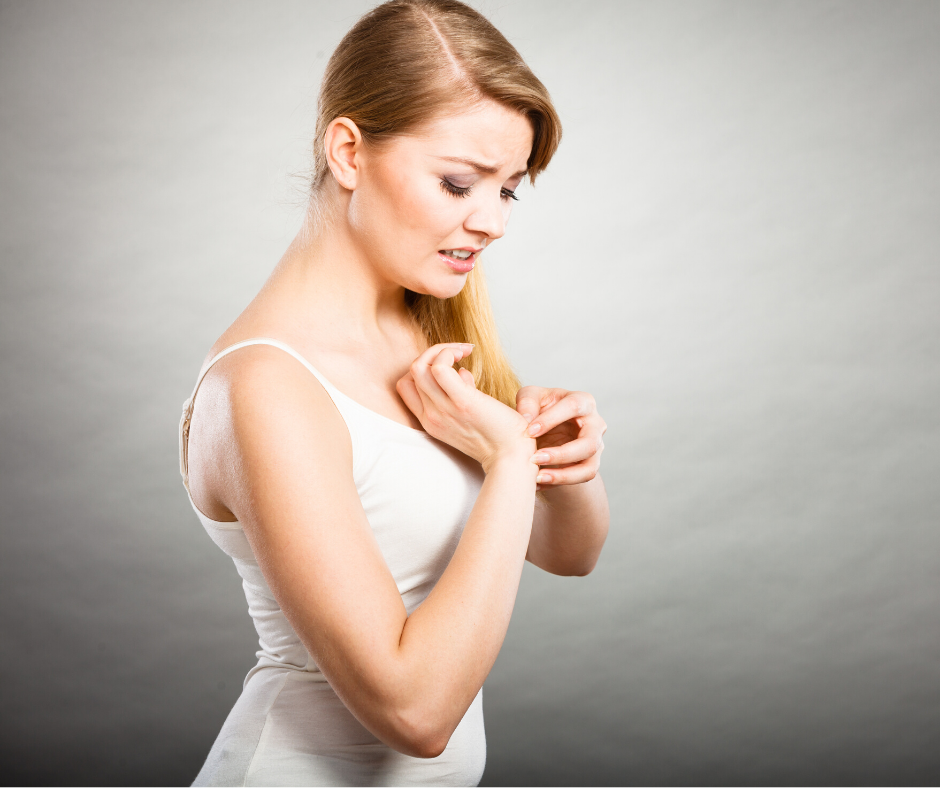
Dermatitis
Dermatitis is inflammation of the skin, it causes red itchy skin, crusty skin and can be blistered or swollen. It effects up to 20% of people at some stage during their life.
Dermatitis is mostly split into two groups Atopic Dermatitis and Contact Dermatitis.
Atopic Dermatitis – other wise known as eczema, is a chronic form of dermatitis there is no known cause or permanent cure but children often outgrow it, Atopic Dermatitis may recur when older if skin Is exposed to irritants. Children can be born with a tendency to develop it. Atopic Dermatitis usually affects the face and skin creases in infants and young children. Behind the knees and inside elbows can get very dry and itchy, this makes broken skin and skin infections become a common problem that leads to further itchiness. In order to avoid aggravating the skin it is advisable to avoid;
*Hot conditions – such as warm weather and hot baths.
*Soaps and perfumes
*Woolen clothing
*Dust and pets
Contact Dermatitis – is when someone can react to a specific substance at times, or people can be sensitive to irritants. Detergents, skin cleaners, acids or alkali's, solvents or other products can be causes. Eventually skin contact with these items will dry the skin and break down its protective layer. Contact Dermatitis most often effects the hands. For people working in certain occupations (Nurses, Cleaners, Builders and Hair Dressers are examples) where there is exposure to irritants regularly makes them more prone to suffer from Contact Dermatitis.
Allergic Contact Dermatitis is a much less common form of Contact Dermatitis and it happens to people that have become over sensitized to contact – even if only occasional exposure to certain everyday products (latex, nickel, jewelry, clothing elastic, plasters and medical strapping tape are prime examples). The rash usually begins on the hands and the rash spreads.
Causes
*Inherited (from family )
*Irritants
*Allergy
*Intolerance
*Dry skin
*Skin infection or injury
Diagnosis
An appointment with your GP is the first step in diagnosis. The skin is often red and scaly and can be hard to determine where the reaction has occurred. Creams and medications are often used and skin tests or nail scrapings can help to determine if there are secondary infections.
Treatment
*Avoid known irritants – wear gloves or protection from chemicals, dust, detergents and water.
*Gentle Cleaning – shower instead of baths, keep water warm rather than hot, use soap free alternatives, pat or dab dry rather than rub.
*Moisturise – use moisturiser or emollient creams regularly and liberally.
*Topical corticosteroids – applied thinly to red itchy patches according to Doctors instructions.
*Pimecrolimus cream – a non steroid cream used in certain situations when steroids aren’t effective or aren’t appropriate.
*Antibiotics – used if an infection is present
*Antihistamines – to help ease itching.
Corticosteroid Cream
Hydrocortisone Cream is a mild corticosteroid cream.
*use according to Doctor or Pharmacist’s advice
*apply only where recommended (not to broken skin)
*use sparingly (using too much can cause the skin to thin).
*use carefully if applying to a child or the face.
Follow instructions on duration of use, where to use it, and how often, if unsure ask.
Living with Dermatitis
Dermatitis is often a long term condition, it is important to look after your skin. If you skin tends to be dry it’s a good idea to avoid excessive bathing, and soaps. Soap substitutes like Aqueous Cream can be used instead.
Emollients or moisturisers are an important core treatment as they help to keep the skins protective barrier intact. They also help to prevent dry skin and the inflammation that can lead to a flare up.
*Applying emollient cream liberally and frequently helps to avoid dry and itchy skin. Ideally it is dabbed into freshly showered skin.
*Use emollients when your skin is clear to keep skin healthy.
*If the itchy rash recurs, continue the emollient cream and use the corticosteroid or non-steroid cream advised by your Doctor as well.
*Antihistamine tablets are helpful especially at night to relieve itching.
*If the rash isn’t improving after 2 weeks seek further consult from your Doctor. It is especially important to see your Doctor if there is a chance of infection.
Click to purchase antihistamines
